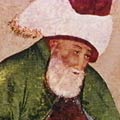
Rumi was probably born on 30 September 1207 in the province of Balkh in the district of Wakhsh in Khorasan (now in modern Afghanistan/Tajikistan). He died on 17 December 1273 in Konya in Seljuqid Rum (now modern Turkey). He was laid to rest beside his father, and over his remains a splendid shrine was erected. A hagiographical account of him is described in Shams ud-Din Ahmad Aflāki’s Manāqib ul-Ārifīn (written between 1318 and 1353). This hagiographical account of his biography needs to be treated with care as it contains both legends and facts about Rumi. For example, Professor Franklin Lewis, Chicago University, in the most complete biography on Rumi has a separate section for the hagiographical biography on Rumi and actual biography about him.
Rumi’s father was Bahā ud-Dīn Walad, a theologian, jurist and a mystic from Wakhsh, who was also known by the followers of Rumi as Sultan al-Ulama or “Sultan of the Scholars”. The popular hagiographer assertions that have claimed the family’s descent from the Caliph Abu Bakr does not hold on closer examination and is rejected by modern scholars. The claim of maternal descent from the Khwarazmshah for Rumi or his father is also seen as a non-historical hagiographical tradition designed to connect the family with royalty, but this claim is rejected for chronological and historical reasons. The most complete genealogy offered for the family stretches back to six or seven generations to famous Hanafi Jurists.
We do not learn the name of Baha al-Din’s mother in the sources, but only that he referred to her as “Māmi” (Colloquial Persian for Māma) and that she was a simple woman and that she lives in 13th century. The mother of Rumi was Mu’mina Khātūn. The profession of the family for several generations was that of Islamic preachers of the liberal Hanafi rite and this family tradition was continued by Rumi (see his Fihi Ma Fih and Seven Sermons) and Sultan Walad (see Ma’rif Waladi for examples of his everyday sermons and lectures).
When the Mongols invaded Central Asia sometime between 1215 and 1220, Baha ud-Din Walad, with his whole family and a group of disciples, set out westwards. According to hagiographical account which is not agreed upon by all Rumi scholars, Rumi encountered one of the most famous mystic Persian poets, ‘Attar, in the Iranian city of Nishapur, located in the province of Khorāsān. ‘Attar immediately recognized Rumi’s spiritual eminence. He saw the father walking ahead of the son and said, “Here comes a sea followed by an ocean.” He gave the boy his Asrārnāma, a book about the entanglement of the soul in the material world. This meeting had a deep impact on the eighteen-year-old Rumi and later on became the inspiration for his works.
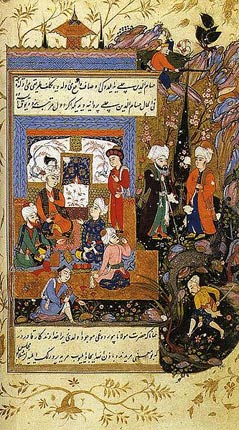
Jalal ad-Din Rumi gathers
Sufi mystics
From Nishapur, Walad and his entourage set out for Baghdad, meeting many of the scholars and Sufis of the city. From there they went to Baghdad, and Hejaz and performed the pilgrimage at Mecca. The migrating caravan then passed through Damascus, Malatya, Erzincan, Sivas, Kayseri and Nigde. They finally settled in Karaman for seven years; Rumi’s mother and brother both died there. In 1225, Rumi married Gowhar Khatun in Karaman. They had two sons: Sultan Walad and Ala-eddin Chalabi. When his wife died, Rumi married again and had a son, Amir Alim Chalabi, and a daughter, Malakeh Khatun.
On 1 May 1228, most likely as a result of the insistent invitation of ‘Alā’ ud-Dīn Key-Qobād, ruler of Anatolia, Baha’ ud-Din came and finally settled in Konya in Anatolia within the westernmost territories of the Seljuk Sultanate of Rûm.
Baha’ ud-Din became the head of a madrassa (religious school) and when he died, Rumi, aged twenty-five, inherited his position as the Islamic molvi. One of Baha’ ud-Din’s students, Sayyed Burhan ud-Din Muhaqqiq Termazi, continued to train Rumi in the Shariah as well as the Tariqa, especially that of Rumi’s father. For nine years, Rumi practiced Sufism as a disciple of Burhan ud-Din until the latter died in 1240 or 1241. Rumi’s public life then began: he became an Islamic Jurist, issuing fatwas and giving sermons in the mosques of Konya. He also served as a Molvi (Islamic teacher) and taught his adherents in the madrassa.
[quote_box_left]When we are dead, seek not our tomb in the earth,
but find it in the hearts of men.[/quote_box_left]
The 13th century Mawlana Mausoleum, with its mosque, dance hall, dervish living quarters, school and tombs of some leaders of the Mevlevi Order, continues to this day to draw pilgrims from all parts of the Muslim and non-Muslim world. Jalal al-Din who is also known as Rumi, was a philosopher and mystic of Islam. His doctrine advocates unlimited tolerance, positive reasoning, goodness, charity and awareness through love. To him and to his disciples all religions are more or less truth. Looking with the same eye on Muslim, Jew and Christian alike, his peaceful and tolerant teaching has appealed to people of all sects and creeds.
Teachings
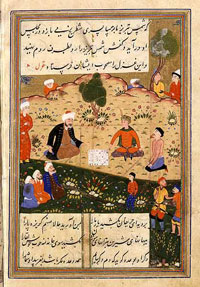
A page of a copy circa 1503 of
the Diwan-e Shams-e Tabriz-i.
The general theme of Rumi’s thought, like that of other mystic and Sufi poets of Persian literature, is essentially that of the concept of tawhīd – union with his beloved (the primal root) from which/whom he has been cut off and become aloof – and his longing and desire to restore it.
The Masnavi weaves fables, scenes from everyday life, Qur’anic revelations and exegesis, and metaphysics into a vast and intricate tapestry. In the East, it is said of him that he was “not a prophet — but surely, he has brought a scripture”.
Rumi believed passionately in the use of music, poetry and dance as a path for reaching God. For Rumi, music helped devotees to focus their whole being on the divine and to do this so intensely that the soul was both destroyed and resurrected. It was from these ideas that the practice of whirling Dervishes developed into a ritual form. His teachings became the base for the order of the Mevlevi which his son Sultan Walad organized. Rumi encouraged Sama, listening to music and turning or doing the sacred dance. In the Mevlevi tradition, samāʿ represents a mystical journey of spiritual ascent through mind and love to the Perfect One. In this journey, the seeker symbolically turns towards the truth, grows through love, abandons the ego, finds the truth and arrives at the Perfect. The seeker then returns from this spiritual journey, with greater maturity, to love and to be of service to the whole of creation without discrimination with regard to beliefs, races, classes and nations.
In other verses in the Masnavi, Rumi describes in detail the universal message of love:
[pull_quote_center]The lover’s cause is separate from all other causes
Love is the astrolabe of God’s mysteries.[/pull_quote_center]
Major works
Rumi’s poetry is often divided into various categories: the quatrains (rubayāt) and odes (ghazal) of the Divan, the six books of the Masnavi. The prose works are divided into The Discourses, The Letters, and the Seven Sermons.
Poetic works
- Rumi’s major work is the Maṭnawīye Ma’nawī (Spiritual Couplets; مثنوی معنوی), a six-volume poem regarded by some Sufis as the Persian-language Qur’an. It is considered by many to be one of the greatest works of mystical poetry. It contains approximately 27000 lines of Persian poetry.
- Rumi’s other major work is the Dīwān-e Kabīr (Great Work) or Diwan-e Shams-e Tabrizi (The Works of Shams of Tabriz; دیوان شمس تبریزی named in honor of Rumi’s master Shams. Besides approximately 35000 Persian couplets and 2000 Persian quatrains, the Divan contains 90 Ghazals and 19 quatrains in Arabic, a couple of dozen or so couplets in Turkish (mainly macaronic poems of mixed Persian and Turkish) and 14 couplets in Greek (all of them in three macaronic poems of Greek-Persian).
Prose works
- Fihi Ma Fihi (In It What’s in It, Persian: فیه ما فیه) provides a record of seventy-one talks and lectures given by Rumi on various occasions to his disciples. It was compiled from the notes of his various disciples, so Rumi did not author the work directly. An English translation from the Persian was first published by A.J. Arberry as Discourses of Rumi(New York: Samuel Weiser, 1972), and a translation of the second book by Wheeler Thackston, Sign of the Unseen(Putney, VT: Threshold Books, 1994).
- Majāles-e Sab’a (Seven Sessions, Persian: مجالس سبعه) contains seven Persian sermons (as the name implies) or lectures given in seven different assemblies. The sermons themselves give a commentary on the deeper meaning of Qur’an and Hadeeth. The sermons also include quotations from poems of Sana’i, ‘Attar, and other poets, including Rumi himself. As Aflakī relates, after Shams-e Tabrīzī, Rumi gave sermons at the request of notables, especially Salāh al-Dīn Zarkūb.
- Makatib (The Letters, Persian: مکاتیب) is the book containing Rumi’s letters in Persian to his disciples, family members, and men of state and of influence. The letters testify that Rumi kept very busy helping family members and administering a community of disciples that had grown up around them.
Philosophical outlook
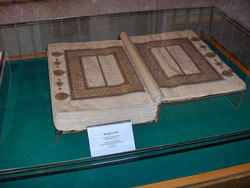
Maṭnawīye Ma’nawī
Mevlana Museum, Konya, Turkey
Rumi was an evolutionary thinker in the sense that he believed that the spirit after devolution from the divine Ego undergoes an evolutionary process by which it comes nearer and nearer to the same divine Ego. All matter in the universe obeys this law and this movement is due to an inbuilt urge (which Rumi calls “love”) to evolve and seek enjoinment with the divinity from which it has emerged. Evolution into a human being from an animal is only one stage in this process. The doctrine of the Fall of Adam is reinterpreted as the devolution of the Ego from the universal ground of divinity and is a universal, cosmic phenomenon. The French philosopher Henri Bergson’s idea of life being creative and evolutionary is similar, though unlike Bergson, Rumi believes that there is a specific goal to the process: the attainment of God. For Rumi, God is the ground as well as the goal of all existence.
[pull_quote_left]I died as a mineral and became a plant,
I died as plant and rose to animal,
I died as animal and I was Man.
Why should I fear? When was I less by dying?
Yet once more I shall die as Man, to soar
With angels bless’d; but even from angelhood
I must pass on: all except God doth perish.
When I have sacrificed my angel-soul,
I shall become what no mind e’er conceived.
Oh, let me not exist! for Non-existence
Proclaims in organ tones,
To Him we shall return.[/pull_quote_left]
However Rumi need not be considered a biological evolutionary creationist. In view of the fact that Rumi lived hundreds of years before Darwin, and was least interested in scientific theories, it is probable to conclude that he does not deal with biological evolution at all. Rather he is concerned with the spiritual evolution of a human being: Man not conscious of God is akin to an animal and true consciousness makes him divine. Nicholson has seen this as a Neo-Platonic doctrine: the universal soul working through the various spheres of being, a doctrine introduced into Islam by Muslim philosophers like Al Farabi and being related at the same time to Ibn Sina’s idea of love as the magnetically working power by which life is driven into an upward trend.
Universality
It is often said that the teachings of Rumi are ecumenical in nature. For Rumi, religion was mostly a personal experience and not limited to logical arguments or perceptions of the senses. Creative love, or the urge to rejoin the spirit to divinity, was the goal towards which every thing moves. The dignity of life, in particular human life (which is conscious of its divine origin and goal), was important.
[quote_center]The nation of Love has a different religion of all religions — For lovers, God alone is their religion.
[/quote_center]
Mewlewī Sufi Order
The Mewlewī Sufi order was founded in 1273 by Rumi’s followers after his death. His first successor in the rectorship of the order was “Husam Chalabi” himself, after whose death in 1284 Rumi’s younger and only surviving son, Sultan Walad (died 1312), favorably known as author of the mystical Maṭnawī Rabābnāma, or the Book of the Rabab was installed as grand master of the order. The leadership of the order has been kept within Rumi’s family in Konya uninterruptedly since then. The Mewlewī Sufis, also known as Whirling Dervishes, believe in performing their dhikr in the form of Sama. During the time of Rumi (as attested in the Manāqib ul-Ārefīn of Aflākī), his followers gathered for musical and “turning” practices.
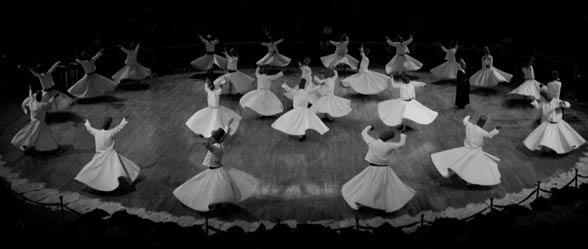
Sufi Dervishes of the Mevlevi Order
According to tradition, Rumi was himself a notable musician who played the robāb, although his favorite instrument was the ney or reed flute. The music accompanying the samāʿ consists of settings of poems from the Maṭnawī and Dīwān-e Kabīr, or of Sultan Walad’s poems. The Mawlawīyah was a well-established Sufi order in the Ottoman Empire, and many of the members of the order served in various official positions of the Caliphate. The center for the Mevlevi was in Konya. There is also a Mewlewī monastery (درگاه, dargāh) in Istanbul near the Galata Tower in which the samāʿ is performed and accessible to the public. The Mewlewī order issues an invitation to people of all backgrounds:
[pull_quote_right]Come, come, whoever you are,
Wanderer, idolater, worshiper of fire,
Come even though you have broken your vows a thousand times,
Come, and come yet again.
Ours is not a caravan of despair.
[/pull_quote_right]
During Ottoman times, the Mevlevi produced a number of notable poets and musicians, including Sheikh Ghalib, Ismail Rusuhi Dede of Ankara, Esrar Dede, Halet Efendi, and Gavsi Dede, who are all buried at the Galata Mewlewī Khāna (Turkish: Mevlevi-Hane) in Istanbul. Music, especially that of the ney, plays an important part in the Mevlevi.
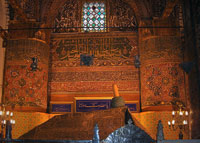
Rumi’s tomb in Konya, Turkey.
With the foundation of the modern, secular Republic of Turkey, Mustafa Kemal Atatürk removed religion from the sphere of public policy and restricted it exclusively to that of personal morals, behavior and faith. On 13 December 1925, a law was passed closing all the tekkes (or tekeyh) (dervish lodges) and zāwiyas (chief dervish lodges), and the centers of veneration to which pilgrimages (ziyārat) were made. Istanbul alone had more than 250 tekkes as well as small centers for gatherings of various fraternities; this law dissolved the Sufi Orders, prohibited the use of mystical names, titles and costumes pertaining to their titles, impounded the Orders’ assets, and banned their ceremonies and meetings. The law also provided penalties for those who tried to re-establish the Orders. Two years later, in 1927, the Mausoleum of Mevlana in Konya was allowed to reopen as a Museum.
In the 1950s, the Turkish government began allowing the Whirling Dervishes to perform once a year in Konya. The Mewlānā festival is held over two weeks in December; its culmination is on 17 December, the Urs of Mewlānā (anniversary of Rumi’s death), called Šabe Arūs (شب عروس) (Persian meaning “nuptial night”), the night of Rumi’s union with God. In 1974, the Whirling Dervishes were permitted to travel to the West for the first time. In 2005, UNESCO proclaimed the “The Mevlevi Sama Ceremony” of Turkey as one of the Masterpieces of the Oral and Intangible Heritage of Humanity.
[/vc_column_text][/vc_column][vc_column width=”1/3″][vc_widget_sidebar sidebar_id=”td-default”][/vc_column][/vc_row][vc_row][vc_column][td_block_7 custom_title=”Browse Rumi Quotes” custom_url=”//esotericquotes.com/rumi/” category_id=”19″ sort=”random_posts” limit=”6″ ajax_pagination=”next_prev”][/vc_column][/vc_row]
